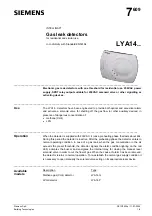
CS220
VELLEMAN
3
After extracting the find, replace the soil and put back the sod as neatly as possible.
Another useful tip is to ‘collect’ all pieces of silver paper or junk that you come across – if you simply throw them
aside, you will probably end up detecting them again later!
9. Maintenance
The working life of your detector will be shortened by careless use or neglect of the unit. Think of your detector as a
scientific instrument – NOT A TOY! Your detector is designed to withstand rugged handling on any terrain, but
misuse or lack of due attention will tell in the end.
After using your detector in a hostile environment (salt water, sand etc.) the exterior parts should be carefully cleaned
with fresh water, paying particular attention to keeping the water from entering the control housing, the head and
stems, then carefully wiped dry. Foreign particles in the control box can be removed by brushing carefully (or with
compressed air or a vacuum cleaner).
The life of the controls may be extended by periodic (every 100 hours of use) application of small quantities of light
lubricant to the spindles, threads and knob grub screws (“3 in 1” or similar household oil is suitable). This operation
requires the knobs to be removed.
Light packing grease should be smeared on the threads of the locking collar, and at the same time, the head fixing
bolt. When not in use, the detector should be stored in a dry environment that is not subject to extreme temperatures.
If it is not to be used for a certain length of time, it is advisable to remove the batteries to avoid leakage, which could
cause serious damage.
If these suggestions are followed, your detector will give you many years of efficient use.
10. Troubleshooting
a) General
- Check the condition of batteries under load using an appropriate tester.
- Interchange batteries and ensure connections are correct and secure. Battery life can vary tremendously between
makes, therefore your ‘new’ batteries may already be insufficiently powerful to run the detector.
b) Oscillating signal or intermittent sound from speaker
- This could be due to poor battery connections. Ensure that they are tight and the batteries are securely clipped into
place.
- Interference from a vehicle using a radio transmitter or possibly a stationary source of electromagnetic radiation – if
this occurs, reduce the sensitivity by detuning the detector. If the problem persists then the best remedy is to wait
until the transmission stops.
c) The detector drifts out of tune
- Temperature drift caused by change in air temperature when a machine is moved from a house or care into the
open. The greater the change in temperature, the more the drift, and in severe conditions up to 30 minutes may be
needed for the electronic circuitry to acclimatise itself.
- Sometimes battery drain can cause drift of signal. Replace batteries and this should help to maintain a stable
signal.
d) In all other cases
Take the detector back to your local retailer with a letter giving full details of fault.
The contents of this manual can be subject to change without prior notification.


































